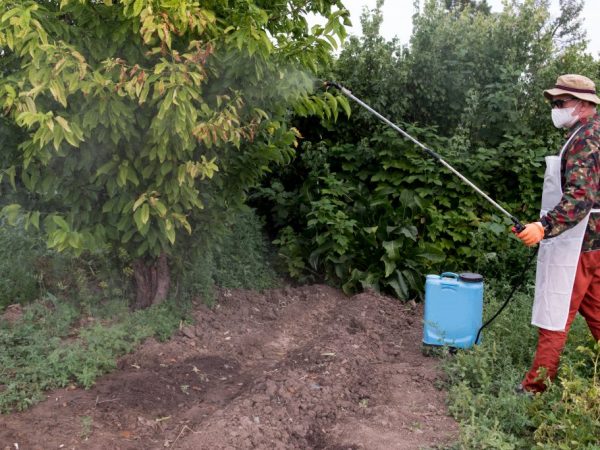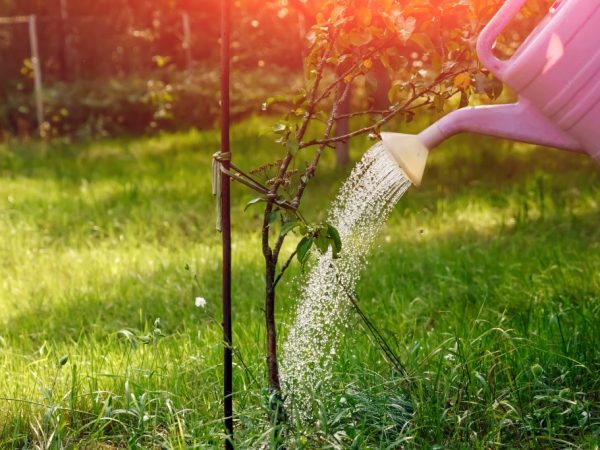Why do you need feeding apple trees in the fall
Top dressing of apple trees in autumn allows you to create protection for the tree and increase its immunity before the winter cold. Autumn fertilization allows a high percentage of flower buds to be laid for the next season.

Why do you need feeding apple trees in the fall
Terms of feeding
Top dressing of an apple tree in autumn refers to the last fertilization for the fruit and berry season. It falls on the first days, immediately after the harvest of apples, but until the moment when the soil is still warm, and the garden culture has not finally passed into a state of dormancy.
Usually, feeding is planned 2-4 weeks before the expected frost.
The approximate time frame depends on the region:
- Ural and Siberia - last week of August - September;
- central and middle lane - second half of September;
- southern regions - including October.
It is worth being guided by the rule: an early autumn procedure is more effective than a belated one. With late application, the culture may not have time to absorb useful substances and use them, and before the onset of spring, most of them will be washed out of the soil layers.
How to fertilize an apple tree
When feeding in the fall, it is worth choosing such fertilizing complexes that:
- strengthen the root system;
- provide winter hardiness;
- will increase immunity to diseases.

Fertilizer is applied at the root
Types of nutritional complexes
It is important to choose the right way to fertilize the apple tree in the fall. Nutrients can be different:
- organic - bird droppings, manure, peat, compost;
- mineral - superphosphate, potassium salt;
- complex - include both organics and minerals.
To achieve all the tasks set, gardeners use those fertilizers that contain high proportions of phosphorus and potassium. The first one strengthens the root system, and the second one increases frost resistance.
In autumn, the use of those compositions where there is nitrogen is avoided (it cannot be completely excluded, since this element promotes the absorption of phosphorus, the maximum dose is up to 10%). Nitrogen causes the active growth of young shoots, which draws off the tree's strength, which it needs for wintering. They do not have time to get stronger in a short time and die when the ambient temperature drops.
Fresh manure is also not used. For root application, it must be rotted so as not to burn the root system of trees.
Root dressing
Fertilizing complexes are applied to the near-stem circle (along the perimeter, close to the root location).
Use both liquid (pre-diluted with water) and dry (granular) dressings.
Liquid has a reduced resistance to moisture, incl. to frequent rain, therefore, the efficiency of feeding with dry components is much higher - they, under the influence of precipitation, dissolve evenly and are absorbed by the root system of trees.
Foliar dressing
Usually, the autumn feeding of apple trees does not imply foliar methods, because with frequent precipitation, this type of fertilizer is quickly washed off and loses its effectiveness. Most often they are resorted to during spring planting.
However, at the end of summer, you can compensate for the lack of nutrition by spraying the foliage with superphosphate (100-150 g per 10 L of water). This is done in order to lay the buds for the next season and increase the yield.
Preparation for feeding
After harvesting, before carrying out autumn dressings, fruit trees are prepared:
- conduct a general examination for the presence of pests and signs of disease;
- clean the affected areas of the tree bark, followed by treatment with copper sulfate and covering with garden pitch;
- remove overgrown mosses and lichens;
- cut off dried branches;
- the soil is pre-dug up.
Feeding rules
You can feed apple trees in autumn using one of the available methods, the choice of a fertilizing complex depends on it. For any of them:
- food is introduced not directly under the trunk, but having retreated from it 0.5-0.7 m, at this distance the roots are located, which will absorb minerals;
- small amounts of fertilizers are buried in the ground or scattered around the perimeter, followed by digging to a depth of 10-15 cm, i.e. 1/2 bayonet shovel;
- trees are fed only in moist soil, therefore, after the introduction of nutrient compositions in a warm and dry autumn, watering is required, especially with granular complexes.
Top dressing for young (not yet fruiting) and for adults (over 5-8 years old) apple trees are different.

Apple trees painlessly survive the winter if properly prepared in the fall.
For young trees
In the fall, you need to feed young apple trees with preparations containing phosphorus and potassium.
Mineral nutrition for a non-fruiting horticultural crop should include these two basic elements. Young seedlings are fed only with liquid, previously diluted in water, fertilizers, usually using:
- a solution of superphosphate (2 tablespoons), potassium sulfate or potassium sulfate (optionally, 2 tablespoons) per 10 liters of water;
- a complex preparation - potassium monophosphate in the calculation of 10 g per 10 l of water;
- with an ash solution (200 g of wood ash per 10 liters of water).
Application standard - 10 liters of working fluid per m².
For mature trees
Old fruiting apple trees require a higher concentration of active substances, therefore the proportion of components for them increases.
They can be fed:
- a solution of superphosphate (4-6 tablespoons), potassium sulfate or potassium sulfate (optional, 2-8 tablespoons) per 10 liters of water;
- complex composition - potassium monophosphate (15 g per 10 l of water);
- dry wood ash 250 pcs / m².
Application standard - 10 liters of working fluid per 1 m².
Old trees respond well to slurry fertilization.
For better care, it is used as an additional top dressing along with the introduction of mineral and organic nutrition.
- Manure or chicken droppings fill the barrel by 1/3.
- The volume is topped up to the brim with water.
- The mixture is kept for 3 days, stirring occasionally.
- The slurry is diluted with water in a ratio of 1: 5, if chicken manure was used instead of manure - in a ratio of 1:10.
This solution is poured over the trunk circle.
Nutrition into the wells
You can feed mature trees by applying liquid fertilizer to the holes:
- grooves are made along the perimeter of the trunk circle to a depth of 0.2 m;
- 1-2 liters of slurry are poured to the bottom;
- sprinkle with earth.
The hole method can also be used when applying granular fertilizers:
- only ½ glass of dry composition is laid out in the holes;
- sprinkle with earth;
- the remaining half of the seven is poured on top, mixed with a layer of earth;
- the fertilized soil is watered.
Additional care for the apple tree
In addition to feeding activities in the fall, when preparing apple trees for wintering, it is worthwhile to carry out additional care, which includes:
- whitewashing boles - this will protect against frost damage and pest damage;
- mulching the trunk circle - this will prevent the soil from freezing, peat, decorative chips or wood ash are suitable for mulching, and if you use rotted manure as mulch, it will additionally become a spring top dressing;
- pruning of diseased, damaged, old branches - this will help alleviate the load on the crown under the pressure of snow;
- hiding - this will keep warm and prevent the garden crop from freezing.

